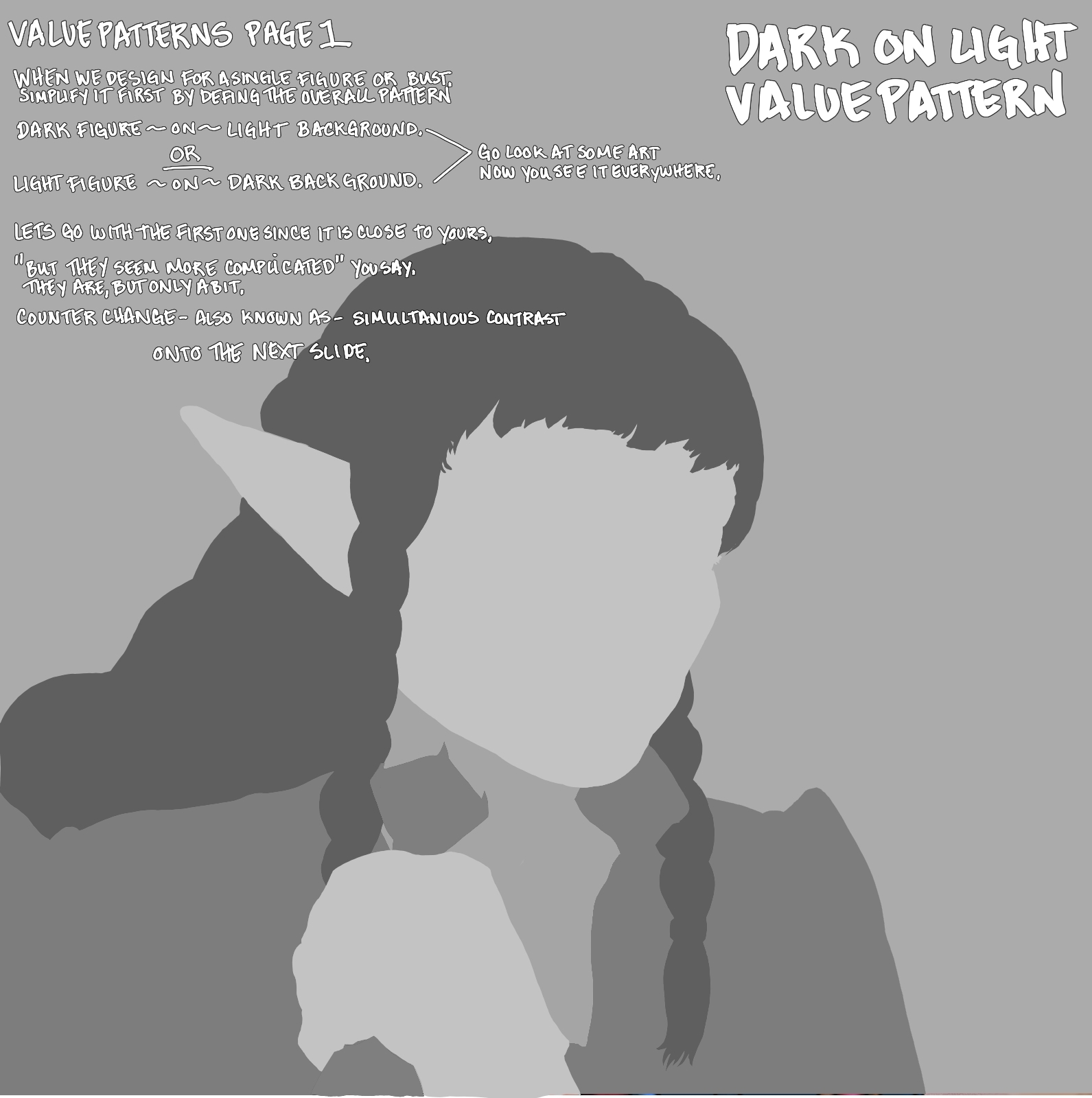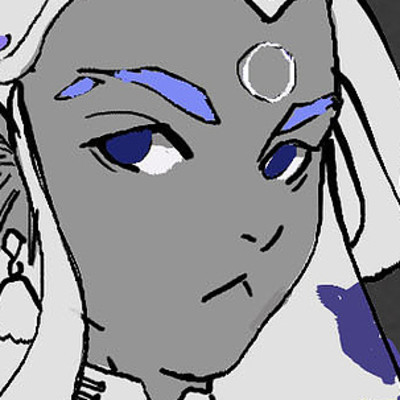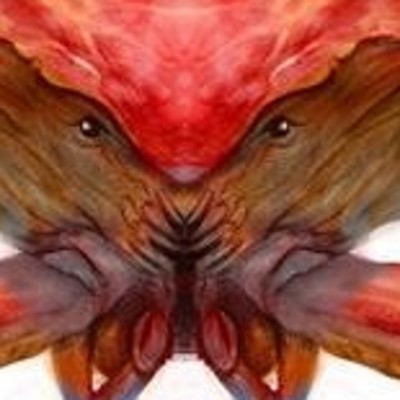Critique Part 2
I want to give you this before we start - and keep it in mind because I am going to circle back to it.
What my goal is for you today through the examples and the paint over – is on clear separation and simplicity – specifically showing you the power of one shadow's edge rather than adding excessive (light and shadow) detail to every wrinkle or fold.
Disclaimer : Any examples I draw or paint over here are not what your art should look like. They are attempts are to show you a theory, tip, or hack to give you a brainwave and motivation to improve your skills. A white knuckled grasp at the next ladder rung. Only you can decide what your art should look like.
I decided to type out everything and work on the paint over this time while still trying to work on the RL stuff. here we go.
1 - Information in the dark (dark subject light background) - Examples
Lets take a look at this.
The main focal point – (large figure) is a dark subject on a light background.
Also - a Cool Figure, on a Warm Background
Victor Ferraz - "Grotesque Gift Legends of Runeterra, By Riot Games"
https://www.artstation.com/artwork/XgZokL

Look how the majority of the figure is in the shadow side of the main big lights notan. We are looking at the shadow side of the figure but we see all of this form information thanks to the ambient light. We also have depth separation with some extra oclussion shadows and even highlights on the more specular parts like the eye, and teeth. Every element (or every single different surface type) only really has two to three values tops. The trick is - it is just the gradients going between each value that we see. Nothing in this shadow side is casting a shadow - but there is plenty of form shadow caused by the bounce light below, and the sky light above.
Look at the Main part hit by the light side however (Where the sun is hitting it on the right side)– this has no highlight and midtone relationship. It is just the mid tone with a glow effect– there is no white anywhere – this simplifies it for the human eye – the more information we have the busier it looks – and the less organized we get as painters and draftsman. Lets move onto some other pieces - but we will come back to a post Victor made just the other day.
Poison Scarlet - Hero Skin by Tales Irie
Dark Figure - Light Background
Cool Figure, on Warm Background

https://www.artstation.com/artwork/nJB4gO
Here we have the same thing again. The majority of the figure composition resides in the dark of the notan. Look at the post to see more process stuff from the artist regarding this value pattern planning. And again - every element either light or dark side has two colors (or values)
2 - Information in the light (light subject dark background)
Lets look again with another one by Victor Ferraz
https://www.artstation.com/artwork/XJ3l8R
Light figure on a dark background.
Warm Figure - on Cool Background

Key light is like a studio light – with diffusion panels in front of it. It is soft, muted and spread out. The opposite of what a spotlight would do.
There is almost no ambient light hitting key light shadow notan. The background light is scarce – and there is no secondary light source like magic or rim light. It sets the mood to a different one than the first piece in this post - incredible that it is the same artist isn't it? It's really fun to see everywhere when people utilize these principles.
Look at the shadows. There is only one dark tone for them for every element.
Same artist. Full control of the four lights we use as illustrators. Fascinating stuff.
The Four Lights
Keylight,
Ambient Light,
Rim Light, and
Background Light.
I highly recommend getting a close up from the link - and pouring over the masterful brushwork and value control. You will learn a lot. It might seem overwhelming - but you will see again that it is mostly two values that are describing all form with a third one (occlusion or highlight) complementing the focal points. (Or providing more information for the eye to digest - thus creating interest - focal interest. The focal points.
Whisperer Azshara - Hero Skin - by Tales Irie
Light figure on Dark Background
Cool Figure - Warm Background

These are the same two artists for separate composition styles. (see the counterchange in color temperature and value as well?)
3 - Lights, shadows, and their names
Our four main lights we use as illustrators:
Lights
Keylight,
Ambient Light,
Rim Light, and
Background Light.
Shadows
Main Shadow
(The main form separation of shape. 2 Values)
(Can be cast shadow or form shadow)
Form Shadow
(created by Ambient light / Bounce Light)
(goes inside the key light shadow shape
(also created by midtones on the light side of notan),
Occlusion shadow
( in the shadow - helps separate the forms and create depth when objects get close.
LIGHT SIDE
Midtones
(In the key light side)
(think of them as form shadows on the light side.)
(But they are also your rich color areas. They have the most area to play with rich and vibrant color - they can get almost dark enough to be misread as shadows)
Highlights
(Inside the Light side of the Key light- The highest peak angled towards the viewer eye.)
Warm / Cool Simultaneous contrast
Go give this specific critique I made last year a read - it covers a few things that I have not covered here and would be good supplemental information. It covers what I have not done here with Hue Counterchange / Simultaneous Contrast.

DEMONSTRATION
1-FAR AWAY WORK SPACE
The artists that came before use with no digital art capabilities had to walk across their studios to see the marks they needed to make. At the museum you will see close up that details are just blobs and blasts of the brush. But far away they are detailed and precise. The cause is our human eye. So we need to paint with this in mind. There are two ways to do this. Paint with an ABSOLUTELY HUGE CINTIQUE, OR TABLET AND SCREEN – that way you don't every have to zoom in.
The other way is to do what I do – with a modest sized monitor and tablet. Set the second window in whatever program you use to always see it in the print size it is going to be printed. Details will be lost when you print something like this for a playing card for example – and the simplification of form shadows that I will talk about in a moment will become so important.
We need it to read at the distance it is most commonly going to be viewed. The only way to do that effectively is to remember to zoom out constantly and get sick all over your keyboard. OR you can keep another window open, make your marks and check them.

If it reads well at this distance we don't need anything else.
2-Composition choices.

Please do not be afraid to check things in actual thumbnail sizes. This is important because you cant always throw it too your phone or another screen. Mirror constantly and make big sweeping changes by getting a second look. We will be working big to small in theory.
3- COUNTERCHANGE -or - SIMULTANEOUS CONTRAST -
An example of just value COUNTERCHANGE
From Top down: Light to Dark Figure, against Dark to Light Background
This makes the interest concentrate where we need it too. It gives a POP from top to bottom for this composition. Again this is just extreme for an example - you might choose a different style of light and background choice.

Your figure is a light figure on a dark background.
It is also a warm figure on a cool background.
The focal point is the face and upper body – lit by a strong and close lamp light that is in front of the torso.
It is warm.
So the choice of the rest of the shadow is going to be cooler because of its relation too it. THAT DOES NOT MEAN that the shadows are blue and the light is orange when YOU paint it. It just has to be cooler to create a clear separation. (side note = Just remember skin is different. Once it bounces around on people it becomes orange in the shadows sometimes.)
Your skin is greenish blue however. A less saturated green, looks warm next to green. Anyway – back too it.

So we are going to use that to our advantage. Although you have a triadic color scheme for the subject – there two points of the triangle in the warm side of the color wheel – so it is predominantly warm.
Using the light lets make here go Warm to cool from top to bottom. And the background the opposite – warm to cool from bottom to top – so the relationships of the overall complimentary color scheme sort of push each other like the value counterchange I was talking about. Here we want that to be very subtle because your mood is very magical and dramatic – we don't need to have the pallet and color scheme be happy and contrasting harshly (read Cearly's mood books to see what I mean) .
4 - Focal Point- Notan – FORM – and Contrast= Re-work
I am no wordsmith. And I had a few different principles that I am trying to convey today. So please stick with me here. I will get through this as fast as possible
Howard Pyle's teachings on values repeat the importance of clarity and simplicity in organizing the light and shadow to show the “essence” of a subject – and composition. This theory was passed down to me from generations of teachers as putting your information either in the light or the shadow – never both. It allows the focal point to stand out – while avoiding visual clutter. Notan, as I have been referring, the balance of light and dark, is foundational to this practice as well. A convenient shortened term – making simplified way to talk about it.
What my goal is for you today through the examples above and the paintover – is on clear separation and simplicity – specifically showing you the power of one shadow's edge rather than adding excessive (light and shadow) detail to every wrinkle or fold.
The point is for the composition to remain harmonious, engaging and draw the viewers eye to the most important areas – the focal points. To tell the “story” with your illustration. Instead of struggle with any sort of technique.
This technique – follows the theory of Howard Pyle's – that strength (in the illustration) is built not through excessive contrasts, but through thoughtful organization.
I want this to be your golden rule to rendering -
In notan, the lightest shadow in the dark side must always be darker than the darkest midtone in the light side. This ensures a clear and harmonious separation between the light and dark. Lets see me try to use that in the figure and their clothing as a demonstration.

Here I have “turned down” the contrasting notan of shadows that you have on clothing. To remove interest and “overly busy” feelings of form in those spots - and simplify.
I have painted areas of occlusion on the hair and near the arm, and the hair behind the back. .
Turned up the contrast by painting harder terminator form shadow on her face.
Look at the examples above. My guiding principle is that there are only so many values and colors you need to use – to make a clean and organized painting.
Notice the pallets – a highlight and midtone, a shadow (core terminator, and some occlusion) and the ambient light bouncing into it.

5 - Face The Music
The face and hands are everything. Often times you want to be able to use an illustration for as many assets as possible. What looks good here this far away – must possibly look good close up – to an extent. Remember, our talk about distance painting.
However – portraits, hands, hair. All of those are very important on female characters for communication. I find myself saving them for last to spend the most time on when everything else is done. That way I have nothing getting in my way of rendering with the correct light and color.
It at least needs to look good for a character card, bust and portrait distance. So I am going to zoom in on my other window a bit – to keep the appropriate distance, and go to town on some details.

6 - "Fix it in Post"
Remember that we are digital artists that can edit anything. Utilize all the tools at our disposal.
It's really fascinating because as long as you get two values of pixels down for every element you can manipulate them to exhibit form however you want with an assortment of layer effects, or gradient maps. I like to just paint form down and adjust later if I need it. Often times I personally increase the levels contrast a bit along with colors. Personally - because as I mix colors on the canvas it gets rather dull. You will learn similar things about yourself as you paint and become your own worst critic.

Closing thoughts
You could go over all of these ideas with your other pieces and start to see how you can use these principles in your own work to make them more professional. I just want to help out as much as I can since you were concerned about making money and this was a proffesional endeavor.
These tools I have gone over are going to be very important for the rest of your life. I want you to watch how other people manipulate these same theories in different practices and styles. Everyone does this same thing in different ways.
Get those resources. Watch and read them. Paint. Ask for more help. That is the circle that you have to keep closing over and over again. Ask the experts who skip all the shit that is not important. Everything is a shape. Simplify.
Paint, ask the experts, learn, and correct. Move on. You will get better and better - to the point where you know what it is you want to study next, and what you want to draw next for fun.
I swear to God you are right on the edge of super pro work. You will grind down a process and stick too it. Go look for warm and cool figure background relationships, figure and background value relationships. Counter change relationships. Observe how all of the pros use this composition method to make everything "POP" off of the page and give it an impact.
And you are going to knock it out of the park. I hope this can make some stuff click for you.
I'm posting this late tonight - and If I have anything after I read over it tomorrow I'll think on it and add it in. - I've already edited it a few times for clarity.
I edited in a video that I wanted you to watch regarding your figure compositions - it took me a moment to find it.
Create scenes with DEPTH that read CLEARLY! - Narrated Procreate Timelapse
And the Large Medium Small techniques for your use of compositions
CHANGE THE WAY YOU SEE SHAPE DESIGN FOREVER! (Really)
Now I'm going to go draw this week and get some stuff put together for my own art posts. This critique has really got me jazzed up for making more stuff and motivated to get learning the things I've put off. Thanks for the opportunity.
Best of luck. Ta for now.










































































